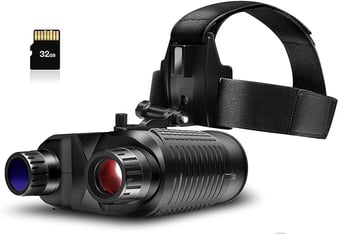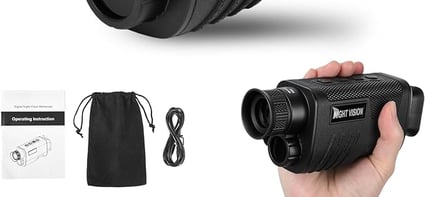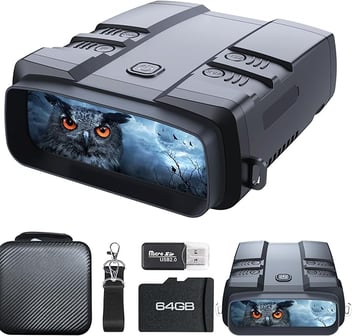Technology of Night Vision Binoculars
SURVIVALNIGHT VISION
2/24/20247 min read
The Fundamentals of Night Vision
Night vision technology represents a pivotal advancement in optical engineering, enabling vision in environments devoid of substantial natural or artificial light. At its core, this technology relies on two primary mechanisms: light amplification and infrared illumination. Light amplification allows devices to collect tiny amounts of ambient light, including lower portions of the infrared light spectrum that are invisible to the naked eye, and amplify them to a level that makes observation possible. Infrared illumination, on the other hand, works by projecting infrared light, which night vision equipment can detect and use to create an image even in complete darkness.
The historical evolution of night vision technology dates back to pre-World War II, but it was during and after the war that significant advancements were made. Initially developed for military use, night vision devices have since permeated a wide range of applications, from wildlife observation to security. Early generations of night vision equipment were bulky and required external infrared illuminators. However, modern devices are more compact, efficient, and capable of operating in almost complete darkness without the need for additional illumination sources.
How Night Vision Goggles Work
Night vision goggles captivate with their ability to convert the invisible into the visible, harnessing the principles of light amplification to illuminate the dark. These devices consist of several key components, including the photocathode, which plays a crucial role in converting photons (light particles) into electrons. An image intensifier tube further amplifies these electrons, which then strike a phosphor screen, converting them back into visible light. This process results in a clear, enhanced image of the surroundings, even in environments with minimal light.
Selecting the Right Night Vision Binoculars
Choosing the appropriate night vision binoculars involves understanding both your needs and the technological specifics of the devices available. The right pair can significantly enhance your nocturnal observations, whether for professional applications, wildlife tracking, or recreational use. Factors such as generation, gain (light amplification level), resolution, and range are critical in determining the effectiveness of night vision binoculars in various environments.
Consider the Generation: Night vision devices are categorized into generations 1 through 4, with each subsequent generation offering improved clarity, range, and performance but at a higher cost. Gen 1 devices are suitable for casual use, while Gen 3 and 4 are preferred for serious professional and military applications.
Assess the Gain: Gain refers to the level of light amplification. A higher gain is preferable in darker conditions, but it also comes with a higher price tag. Balance your need for brightness against your budget.
Check the Resolution: Resolution affects the sharpness and clarity of the image. Higher resolution binoculars provide more detailed images, crucial for tasks requiring identification of specific features in the dark.
Evaluate the Range: The effective range is how far you can see with the binoculars in low light conditions. Consider the typical distances you'll need to cover with your observations to choose a suitable model.
Battery Life Matters: Longer battery life ensures uninterrupted use during extended periods in the field. Check for energy-efficient models that balance performance with battery longevity.
Understand the Environment: The environmental conditions you'll be operating in (e.g., rural vs. urban) can influence the type of night vision binoculars you need, as ambient light levels vary significantly.
Additional Features: Look for additional features such as built-in infrared illuminators, water resistance, and rugged design, which can enhance the utility and durability of your night vision binoculars.
Optimizing Night Vision Use
To maximize the effectiveness and lifespan of your night vision binoculars, understanding and implementing best practices is crucial. These tips can help you get the most out of your investment and ensure reliable performance during critical moments.
Avoid Bright Light Exposure: Direct exposure to bright lights can damage the sensitive components of night vision binoculars. Always turn off the device before facing light sources.
Regular Calibration and Maintenance: Regularly check and calibrate your night vision equipment to maintain optimal performance. This includes cleaning the lenses with appropriate tools and checking for software updates if your model supports them.
Strategic Use of IR Illuminators: Built-in or external infrared illuminators can significantly improve visibility in complete darkness. Use them strategically to enhance image quality without revealing your position.
Enhancing Darkness: Mastering the Night with Vision Goggle Technology
Selecting the right survival knife and machete is not just about choosing tools; it's about preparing for the unpredictable nature of the wild. The blade design, handle grip, and durability form the foundation of a reliable survival knife, capable of performing a range of tasks from precision cutting to robust chopping. The survival machete extends this capability, offering the power to clear paths, gather materials, and provide defense.
Protection and readiness extend to the sheaths and storage solutions that preserve the functionality of these tools. And beyond the immediate utility of cutting tools, the integration of survival kits, including a well-prepared tactical medkit bug out bag, embodies the essence of survival preparedness—anticipating needs and preparing for challenges.
In the end, the choice of survival gear is deeply personal, reflecting individual needs, experiences, and the specific demands of the environment. Armed with technical knowledge and practical insights, you're now equipped to select tools that aren't just carried on the belt or in a bag but are true extensions of your survival instinct. The edge of survival isn't found in the blade alone but in the preparedness and resilience of the one who wields it.
Evaluating Night Vision Binoculars: Key Criteria
Consideration of these technical specifications must be coupled with an assessment of the device's durability and ease of use. Features such as water resistance, shockproof construction, and ergonomic design contribute to the binoculars’ longevity and user satisfaction. Ultimately, the choice of night vision binoculars hinges on a balance between desired performance characteristics and practical considerations like cost and portability. By applying a rigorous evaluation framework, users can navigate the vast array of options available, selecting a model that best fits their specific observational needs and operational contexts. This decision-making process, grounded in a clear understanding of both technical capabilities and practical usability, sets the stage for the effective and satisfying use of night vision technology.
"Cost and Affordability in Night Vision"
The Science Behind Why Night Vision Is Green
The iconic green hue seen through night vision goggles is not just a stylistic choice but a deliberate design feature rooted in the limitations and capabilities of human vision. Our eyes are more sensitive to green light, and by displaying the amplified light in shades of green, NVGs can provide clearer, more detailed images. This aspect of night vision technology underscores the importance of understanding and adjusting the goggles' electronic settings, such as gain control, brightness, and contrast, to adapt to various nocturnal environments. Familiarizing oneself with these adjustments and conducting regular tests in the field can significantly improve the goggles' effectiveness. Integrating NVGs with other technologies, like GPS systems or mobile applications, further enhances their utility, offering users a comprehensive and enriched viewing experience. Investing time in understanding and fine-tuning these configurations ensures that night vision goggles meet the high standards of performance required by both professionals and enthusiasts, leveraging the science behind our perception of green light to maximize visibility and detail in low-light conditions.
Configuring and Optimizing NVGs
Configuring and optimizing night vision goggles (NVGs) involves a comprehensive approach that extends well beyond selecting the ideal model. This meticulous process begins with the assembly of the goggles, ensuring any supplementary components, like IR illuminators or special lenses, are correctly attached. Precision at this stage is critical; minor errors in alignment can substantially impact the clarity and quality of the night vision. Additionally, the setup must be tailored to the environment of use. Urban settings, with their inherent ambient light, necessitate different adjustments than completely dark rural or wilderness areas. Such customization is vital for achieving the best possible visual performance, enabling users to observe their surroundings with enhanced clarity.
Evaluating Night Vision Binoculars: Key Criteria
The selection of night vision binoculars should be informed by a comprehensive evaluation of key performance metrics and user-specific needs. Critical criteria include image resolution and clarity, which determine the detail and sharpness of observed objects, and the device's field of view, which affects how much of the environment can be seen at one time. The magnification level is another important factor, balancing the need for closer views against the potential for increased image instability. Additionally, the sensitivity of the device to low levels of light, often indicated by its minimum illumination requirement, reveals its ability to perform in near-total darkness.
We recommend these head mounted night vision binoculars.
"Ensure whatever night vision system you get is durable."
As an Amazon Affiliate items and images are linked on this page and may earn our team commission. We pick the products - no catch.
4K Ultra Night Vision Binoculars - Revolutionizing Nighttime Observation
Ultra Night Vision Binoculars
Designed for Survival: Revolutionize nighttime observation with crystal-clear visibility in total darkness using VABSCE's advanced focusable IR Illuminator technology.
Beyond 4K Clarity: The 5x digital zoom broadens your field of view, while the large viewing experience enriches playback. Capture and relive the vibrant moments of nocturnal wildlife with unparalleled clarity.
onewordsurvive.com
Contact | Questions | Ideas
survive@onewordsurvive.com
Cookie Notice: Our website uses cookies to enhance your browsing experience. By continuing to use our site, you agree to our use of cookies. If you wish to manage your cookie preferences, you may do so in your browser settings.
As an Amazon Affiliate, our team may earn money from qualifying purchases. This page may contain affiliate links, which means if you click through and make a purchase, we may receive a commission at no additional cost to you. This helps support our research and editorial team, and please know we only recommend high-quality products.














